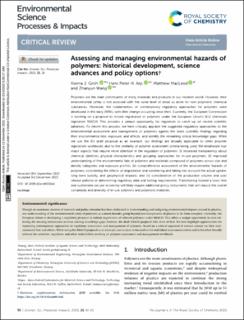| dc.description.abstract | Polymers are the main constituents of many materials and products in our modern world. However, their environmental safety is not assessed with the same level of detail as done for non-polymeric chemical substances. Moreover, the fundamentals of contemporary regulatory approaches for polymers were developed in the early 1990s, with little change occurring since then. Currently, the European Commission is working on a proposal to initiate registration of polymers under the European Union's (EU) chemicals legislation REACH. This provides a unique opportunity for regulation to catch up on recent scientific advances. To inform this process, we here critically appraise the suggested regulatory approaches to the environmental assessment and management of polymers against the latest scientific findings regarding their environmental fate, exposure, and effects, and identify the remaining critical knowledge gaps. While we use the EU draft proposal as an example, our findings are broadly applicable to other polymer legislations worldwide, due to the similarity of polymer assessment criteria being used. We emphasize four major aspects that require more attention in the regulation of polymers: (i) increased transparency about chemical identities, physical characteristics and grouping approaches for in-use polymers; (ii) improved understanding of the environmental fate of polymers and materials composed of polymers across size and density categories and exposure profiles; (iii) comprehensive assessment of the environmental hazards of polymers, considering the effects of degradation and weathering and taking into account the actual uptake, long-term toxicity, and geophysical impacts; and (iv) consideration of the production volume and use/release patterns in determining regulatory data and testing requirements. Transitioning toward a toxic-free and sustainable circular economy will likely require additional policy instruments that will reduce the overall complexity and diversity of in-use polymers and polymeric materials.
Polymers are the main constituents of many materials and products in our modern world. However, their environmental safety is not assessed with the same level of detail as done for non-polymeric chemical substances. Moreover, the fundamentals of contemporary regulatory approaches for polymers were developed in the early 1990s, with little change occurring since then. Currently, the European Commission is working on a proposal to initiate registration of polymers under the European Union's (EU) chemicals legislation REACH. This provides a unique opportunity for regulation to catch up on recent scientific advances. To inform this process, we here critically appraise the suggested regulatory approaches to the environmental assessment and management of polymers against the latest scientific findings regarding their environmental fate, exposure, and effects, and identify the remaining critical knowledge gaps. While we use the EU draft proposal as an example, our findings are broadly applicable to other polymer legislations worldwide, due to the similarity of polymer assessment criteria being used. We emphasize four major aspects that require more attention in the regulation of polymers: (i) increased transparency about chemical identities, physical characteristics and grouping approaches for in-use polymers; (ii) improved understanding of the environmental fate of polymers and materials composed of polymers across size and density categories and exposure profiles; (iii) comprehensive assessment of the environmental hazards of polymers, considering the effects of degradation and weathering and taking into account the actual uptake, long-term toxicity, and geophysical impacts; and (iv) consideration of the production volume and use/release patterns in determining regulatory data and testing requirements. Transitioning toward a toxic-free and sustainable circular economy will likely require additional policy instruments that will reduce the overall complexity and diversity of in-use polymers and polymeric materials. | en_US |

